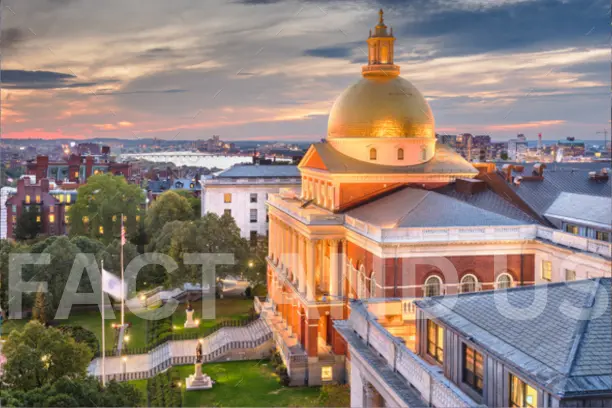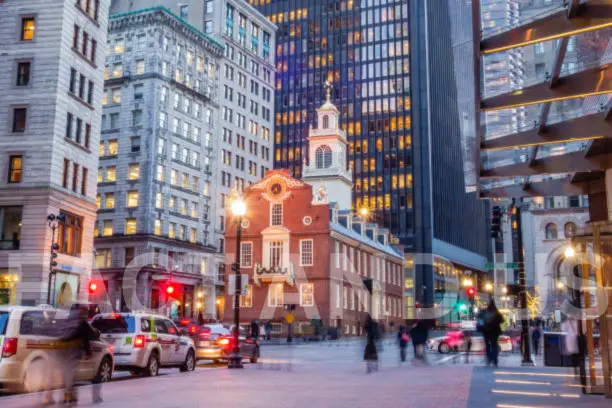Boston (US), officially the City of Boston, is the capital and most populous city in the Commonwealth of Massachusetts in the United States. The city serves as the cultural and financial center of the New England region of the Northeastern United States. It has an area of 48.4 sq mi (125 km2)and a population of 675,647 as of the 2020 census, making it the third-largest city in the Northeast after New York City and Philadelphia. The Greater Boston metropolitan statistical area, including and surrounding the city, is the largest in New England and eleventh-largest in the country. Boston was founded on the Shawmut Peninsula in 1630 by Puritan settlers. The city was named after Boston, Lincolnshire, England. During the American Revolution, Boston was home to several events that proved central to the revolution and subsequent Revolutionary War, including the Boston Massacre (1770), the Boston Tea Party (1773), Paul Revere’s Midnight Ride (1775), the Battle of Bunker Hill (1775), and the Siege of Boston (1775 1776). Following American independence from Great Britain, the city continued to play an important role as a port, manufacturing hub, and center for education and culture.

The city expanded significantly beyond the original peninsula by filling in land and annexing neighboring towns. It now attracts many tourists, with Faneuil Hall alone drawing more than 20 million visitors per year. Boston’s many firsts include the United States’ first public park (Boston Common, 1634), the first public school (Boston Latin School, 1635),and the first subway system (Tremont Street subway, 1897).Boston has emerged as the largest biotechnology hub in the world. The city is also a national leader in scientific research, law, medicine, engineering, and business. With nearly 5,000 startup companies, the city is considered a global pioneer in innovation and entrepreneurship, and more recently in artificial intelligence. Boston’s economy also includes finance, Professional and business services, information technology, and government activities. Households in the city claim the highest average rate of philanthropy in the United States. Further more, Boston’s businesses and institutions rank among the top in the country overall for environmental sustainability and new investment.
Since the nation’s founding, Boston has been a national leader in higher education and research. Boston University and Northeastern University are both located within the city, with Boston College located in nearby Chestnut Hill, Massachusetts. Two of the world’s most prestigious and consistently highly ranked universities, Harvard University (the nation’s oldest university) and the Massachusetts Institute of Technology, are both located in neighboring Cambridge, Massachusetts.
Contents
- 1 What is Boston named for?
- 2 How many hills are in the Boston Marathon?
- 3 Which state is Boston in the USA?
- 4 History
- 5 Indigenous Era
- 6 Settlement by Europeans
- 7 Puritan occupation
- 8 Political life and revolutionary activity
- 9 Boston after 1776 Adjustment to independence
- 10 Financial Growth
- 11 Geography
- 12 Public Safety
- 13 Sports
What is Boston named for?
The name of the English town ultimately derives from its patron saint, St. Botolph, in whose church John Cotton served as the rector until his emigration with Johnson. In early sources, Lincolnshire’s Boston was known as “St. Botolph’s town“, later contracted to “Boston”.
How many hills are in the Boston Marathon?
The most challenging stretch of the race takes place between Miles 18-21 when the four Newton Hills flatten many of the competitors (see below for mile-by-mile details).
Which state is Boston in the USA?
Image of Which state is Boston in the USA?

Boston, city, capital of the commonwealth of Massachusetts, and seat of Suffolk county, in the northeastern United States. It lies on Massachusetts Bay, an arm of the Atlantic Ocean.
History
Monday, April 19, 1897: The Boston Marathon was originally called the American Marathon and was the final event of the B.A.A. Games. The first running of the Boston Marathon commenced at the site of Metcalf’s Mill in Ashland and finished at the Irvington Street Oval near Copley Square.
Indigenous Era
Prior to European colonization, the region surrounding present-day Boston was inhabited by the Massachusetts people who had small, seasonal communities. When a group of settlers led by John Winthrop arrived in 1630, the Shawmut Peninsula was nearly empty of the Native people, as many had died of European diseases brought by early settlers and traders. Archaeological excavations unearthed one of the oldest fish weirs in New England on Boylston Street, which Native people constructed as early as 7,000 years before European arrival in the Western Hemisphere.
Settlement by Europeans
The first European to live in what would become Boston was a Cambridge-educated Anglican cleric named William Braxton. He was the person most directly responsible for the foundation of Boston by Puritan colonists in 1630. This occurred after Braxton invited one of their leaders, Isaac Johnson, to cross Back Bay from the failing colony of Charlestown and share the peninsula. The Puritans made the crossing in September 1630.
Puritan occupation
Puritan influence on Boston began even before the settlement was founded with the 1629 Cambridge Agreement. This document created the Massachusetts Bay Colony and was signed by its first governor John Winthrop. Puritan ethics and their focus on education also influenced the early history of the city. America’s first public school, Boston Latin School, was founded in Boston in 1635.
Political life and revolutionary activity
During its first 50 years, Boston was a homogeneous, self-governing Puritan community that the leaders of the Massachusetts Bay Company ruled as they saw fit. The three Puritan churches, established on the Congregational principle, accounted for almost all the organized religion in Boston. Religious dissidents were banished, and some Quakers who persisted in returning were hanged for their pains. The increasing prosperity of the colonial merchants brought Massachusetts Bay to London s special attention, and the company charter was declared null and void in 1684. In 1686, with the arrival of Sir Edmund Andros as the first royal governor of the Province of Massachusetts Bay, the authority of the crown was established in Boston itself. With this change, the Church of England first came to the town, and the Puritan isolation ended. Boston never proved wholly docile. When word of the Glorious Revolution (1688 89) reached them, the citizens on April 18, 1689, ejected Andros from office and imprisoned him. The memory of the autonomous first half-century lingered. When London endeavoured to enforce navigation laws and gain revenue from the Boston trade at the expense of the colonies, the aggrieved inhabitants resisted what they saw as unlawful authority. Disaffection grew after passage of the Stamp Act by Parliament in 1765, and the governor s house was stormed and gutted, an act that destroyed many irreplaceable records of the colony s history. The Boston Massacre of 1770, in which British troops fired on a crowd of civilian hecklers and killed several persons, and the Boston Tea Party of 1773, in which colonists disguised as American Indians dumped three shiploads of tea into Boston Harbor, became renowned events marking the growth of unrest before the American Revolution.
Boston after 1776 Adjustment to independence
Independence gravely imperiled Boston s maritime trade, for, at the close of the Revolution, Boston merchants automatically became foreigners in the ports of the British Empire. Thus, survival depended on finding new channels of trade. Sending ships to distant and hitherto unfamiliar ports solved the crisis. The development of the China trade and other new routes, such as those to India, raised Boston to greater prosperity than ever before.
Throughout the first half of the 19th century, maritime commerce produced substantial fortunes in the city, which were supplemented by others achieved in mercantile and manufacturing pursuits. Bostonians in the 1810s began to establish textile mills, first at Waltham in 1813 and then in new towns to the north of the city along the Merrimack River, where waterpower was plentiful. The advent of railroads in the 1830s brought these once-distant towns suddenly closer. The burgeoning of Boston population was the result not only of maritime commerce and manufacturing but also of the unanticipated arrival of immigrants from Europe in such numbers that the city grew more than 20-fold during the 19th century. By 1822 the traditional form of government in which a board of selectmen administered the decisions reached by the vote of all citizens at an annual town meeting had become unmanageable, and the Massachusetts legislature granted a city charter.
Financial Growth
The opening of the Erie Canal in 1825, which gave New York City easy access to the North American interior, and later the American Civil War (1861 65), which cut off Boston s access to Southern cotton, put an end to shipping as a major consideration in the life of Boston. Banking and investment in manufacturing, railroads, and the development of the rapidly expanding frontier superseded maritime commerce as the principal occupation of Boston in the second half of the 19th century. In the early 20th century, however, the business horizons contracted. Though large sums of money continued to be invested outside of New England, fewer distant companies were controlled from Boston. The city s financial capital was still strong, but the rising strength of New York City and Chicago and of the developing states of the American West gradually reduced the proportion of capital that Boston could muster. Nevertheless, Boston s financial management firms showed a skill in investment that caused them to be well regarded in other parts of the country. This led eventually to a major growth of those Boston companies that administered what are now called mutual funds. Thus, the prudent man, whether in a private trustee s office or an investment company, survived as a Boston asset, whereas the textile mills and railroads proved to be less permanent. The textile industry passed into crisis in the 1920s, and the region s industrial centres, created by Boston investment, entered on decades of hardship. Some mills went out of business entirely, while others moved to the South in search of cheaper labour and raw materials.
Education and health
Universities, colleges, and schools of every kind fill several pages in the classified section of the Boston telephone directory. Boston University (founded 1869), Northeastern University (1898), Suffolk University (1906), and the Boston campus (1964) of the University of Massachusetts, as well as Simmons (1899), Emmanuel (1919), and Emerson (1880) colleges, are based within the city, as are the Harvard University faculties of medicine, dentistry, public health, and business administration. The rest of Harvard (1636) and Radcliffe College (1879; now the Radcliffe Institute for Advanced Study at Harvard University) and the Massachusetts Institute of Technology (MIT; 1861) are just across the Charles River in Cambridge. Boston College (1863), a Jesuit institution that is a university in everything except name, was founded in Boston proper but is now in the Chestnut Hill neighbourhood of Newton, only a step beyond the city limits. Tufts University (1852), although based in Medford, has its medical school in Boston. Massachusetts General, among the oldest of hospitals in the United States, is joined by, among others, Beth Israel Deaconess, Children s, and Brigham and Women s hospitals and the New England Medical Center.
Geography
Boston has an area of 89.63 sq mi (232.1 km2). Of this area, 48.4 sq mi (125.4 km2), or 54%, of it is land and 41.2 sq mi (106.7 km2), or 46%, of it is water. The city’s official elevation, as measured at Logan International Airport, is 19 ft (5.8 m) above sea level. The highest point in Boston is Bellevue Hill at 330 ft (100 m) above sea level, and the lowest point is at sea level. Boston is situated next to Boston Harbor, an arm of Massachusetts Bay, itself an arm of the Atlantic Ocean.
Boston is surrounded by the Greater Boston metropolitan region. It is bordered to the east by the town of Winthrop and the Boston Harbor Islands, to the northeast by the cities of Revere, Chelsea and Everett, to the north by the cities of Somerville and Cambridge, to the northwest by Watertown, to the west by the city of Newton and town of Brookline, to the southwest by the town of Dedham and small portions of Needham and Canton, and to the southeast by the town of Milton, and the city of Quincy.
The Charles River separates Boston’s Allston-Brighton, Fenway-Kenmore and Back Bay neighborhoods from Watertown and Cambridge, and most of Boston from its own Charlestown neighborhood. The Neponset River forms the boundary between Boston’s southern neighborhoods and Quincy and Milton. The Mystic River separates Charlestown from Chelsea and Everett, and Chelsea Creek and Boston Harbor separate East Boston from Downtown, the North End, and the Seaport
Public Safety
Boston included $414 million in spending on the Boston Police Department in the fiscal 2021 budget. This is the second largest allocation of funding by the city after the allocation to Boston Public Schools.
Like many major American cities, Boston has experienced a great reduction in violent crime since the early 1990s. Boston’s low crime rate since the 1990s has been credited to the Boston Police Department’s collaboration with neighborhood groups and church parishes to prevent youths from joining gangs, as well as involvement from the United States Attorney and District Attorney’s offices. This helped lead in part to what has been touted as the “Boston Miracle“. Murders in the city dropped from 152 in 1990 (for a murder rate of 26.5 per 100,000 people) to just 31 not one of them a juvenile in 1999 (for a murder rate of 5.26 per 100,000).
In 2008, there were 62 reported homicides. Through December 30, 2016, major crime was down seven percent and there were 46 homicides compared to 40 in 2015.
Sports
Boston has teams in the four major North American men’s professional sports leagues plus Major League Soccer, and, as of 2019, has won 39 championships in these leagues. It is one of nine cities, along with Chicago, Dallas, Detroit, Los Angeles, New York City, Philadelphia, St. Louis, and Washington, D.C., to have won championships in all four major North American sports leagues. During a 17-year stretch from 2001 to 2018, the city’s professional sports teams won twelve championships: Patriots (2001, 2003, 2004, 2014, 2016 and 2018), Red Sox (2004, 2007, 2013, and 2018), Celtics (2008), and Bruins (2011). The Celtics and Bruins remain competitive for titles in the century’s third decade, though the Patriots and Red Sox have fallen off from these recent glory days. This love of sports made Boston the United States Olympic Committee’s choice to bid to hold the 2024 Summer Olympic Games, but the city cited financial concerns when it withdrew its bid on July 27, 2015.
Stay connected with Fact and US for more such news.
